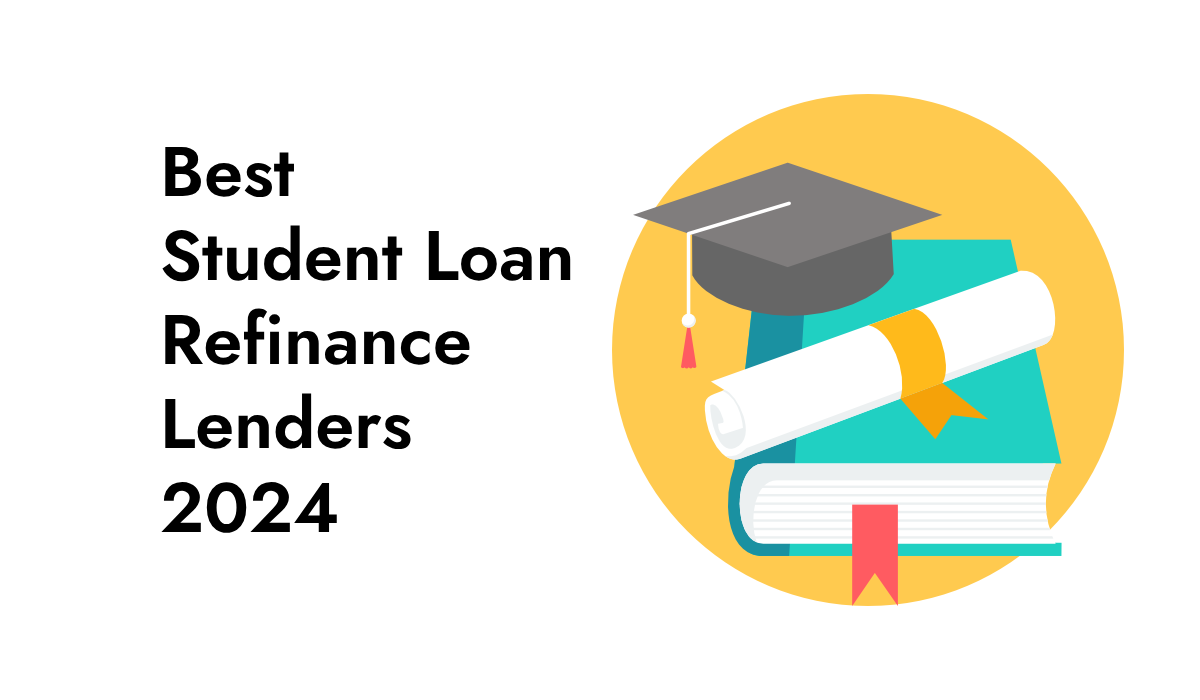Student Loan Lenders 2024
It is possible to save a lot of money by refinancing your student loans. When you refinance, your old student loans are paid off by a new private company, usually a bank, credit union, or online lender. You can then get a new loan with a different interest rate.
We’ve listed the best student loan refinance lenders below for those who qualify, based on things like interest rates, availability to borrowers, and choices for people who are having trouble making payments.
The lenders on our list don’t charge fees for getting a loan or paying it off early, but some do charge fees for being late. In some cases, they have a different refinancing option for people with parent loans. We only looked at their student loan refinancing option when rating them.
Related: Best Home Loan Providers 2024

- Est APR = 4.89-9.04%
- MIn Credit Score = 680
- No fees.
4
editorial team. We score based on factors
that are helpful for consumers, such as
how it affects credit scores, the rates and
fees charged, the customer experience,
and responsible lending practices.
How to Compare Lenders for Refinancing Your Student Loans?
Since the point of refinancing is to save money on interest, you should probably go with the loan that gives you the best rate. Most of the time, variable rates are cheaper than fixed rates, but they could go up in the future. If you plan to pay off your loan quickly, you should choose a variable rate.
Like private student loans for people who are still in school, refinance loans don’t have to offer the same consumer protections as federal loans, like repayment plans based on salary or loan forgiveness.
But some refinance lenders offer more than the standard 12 months of forbearance during the loan term, as well as more loan modification choices for people who are having trouble making their payments.
Most of the time, people who have stable jobs and good incomes should refinance. But life is hard to plan. If you think you might need to stop making payments or lower your monthly bill, you might want to find a loan with a more flexible forbearance policy.
If you do decide to refinance with a co-signer, make sure you choose a loan with a co-signer release policy. This way, you can take on the full repayment responsibility whenever you can. That will protect your co-signer’s credit from the bad marks that could show up if you don’t pay on time.
Related: How to get preapproved for a home loan? Step-by-step Process
Methodology to Get a Student Loan
There are 16 main lenders in the student loan refinancing market. We asked for information from them and scored them on 15 factors, including interest rates, fees, loan terms, hardship choices, the application process, and who is eligible. We picked the 10 best ones to show you based on how many stars they got.
Here is how much weight was given to each category:
- Options for hardship: 30%
- 18% must be eligible.
- Terms of the loan: 18%
- 16% of the application process
- Rates of interest: 13%
- Fees: 5%
Some of the things that were looked at in each category were the number of months of forbearance that were available, hardship repayment options that went beyond traditional forbearance, the ability for borrowers without a bachelor’s degree to get help, the time it took to default, the credit score and income requirements that were made public, and other things.
Related: How to Get a Personal Loan With Bad Credit
Best personal loan

- Est. APR = 6.99%
- Loan type : Personal
- Loan amount: $1k - $50k
- Min credit score: 580
4.3
editorial team. We score based on factors
that are helpful for consumers, such as
how it affects credit scores, the rates and
fees charged, the customer experience,
and responsible lending practices.
Best personal loan for bad credit
- Est. APR = 6.99-35.99%
- Loan Amount = $100-$40K
- Min Credit Score = 300
4.8
editorial team. We score based on factors
that are helpful for consumers, such as
how it affects credit scores, the rates and
fees charged, the customer experience,
and responsible lending practices.
Best personal loan for bad credit

- Est. APR = 9.99 - 39.99%
- Loan Amount = $1k - $50k
- Min Credit Score = 580
4.8
editorial team. We score based on factors
that are helpful for consumers, such as
how it affects credit scores, the rates and
fees charged, the customer experience,
and responsible lending practices.
Best Personal Loan for No Credit

- Est. APR 7.80% - 35.99%
- Loan amount $1k– $50k
- Min credit score 300
4
editorial team. We score based on factors
that are helpful for consumers, such as
how it affects credit scores, the rates and
fees charged, the customer experience,
and responsible lending practices.

- Est. APR 5.99% to 35.99%
- Loan amount $500 to $5,000
- Min credit score = Any
3.7
editorial team. We score based on factors
that are helpful for consumers, such as
how it affects credit scores, the rates and
fees charged, the customer experience,
and responsible lending practices.
- Est. APR 5.99%-35.99%
- Loan amount $1Kto $35K
- Min credit score = 580
4.4
editorial team. We score based on factors
that are helpful for consumers, such as
how it affects credit scores, the rates and
fees charged, the customer experience,
and responsible lending practices.
- Flexible loan amounts
- 24/7 Support
- No prepayment fees
4
editorial team. We score based on factors
that are helpful for consumers, such as
how it affects credit scores, the rates and
fees charged, the customer experience,
and responsible lending practices.
How Student Loans Can Be Refinanced
If refinancing makes financial sense for you, you can get started right away. This is how you can restructure your loans:
Do some research before applying. You can prequalify for a loan from the majority of refinance lenders. Entering a few personal details will enable the lender to perform a soft credit check, which will not affect your credit score.
Once this is done, the lender will provide your projected fixed and variable interest rates for the loan you have selected. Check for the best deals by doing this with multiple lenders.
Send in an application. Once you’ve determined the lender you wish to deal with, formally apply. This is a longer form, so you might need to enclose additional supporting evidence regarding your earnings and other information.
The lender will then verify your details through a rigorous credit check. You will be sent a summary of the final loan terms if you are approved. If everything checks out, you can sign the paperwork to be approved for the loan.
Verify that your previous loan has been closed, then begin making payments. Your previous loan will probably be paid off in full by your new lender. But until you get word that your account has been closed and your debt has been paid off, keep up with your payments on your previous obligation. Following that, you will be required to make consistent payments on your refinanced debt to your new lender.
Is it worth it to refinance student loans?
You should refinance your student loans if you have a stable job and good credit so that you can get a low interest rate. This will save you money in the long run. There are no up-front costs because most lenders don’t charge application or transaction fees.
But it’s important to pick the right loan time. If you extend the time you have to pay back your student loans, your monthly payments may go down, but the interest you pay over time may go up. If possible, the lower interest rate should be what lowers your payment when you refinance, not the longer term.
Your credit might not save you much money if you can’t get a lower interest rate than the one you have now and your credit score is fair or bad (below 670 on the FICO scale). It’s also a good idea to keep your federal student loans if your job is uncertain or if you think you might need to use payment relief options like deferment, loan forgiveness, or income-driven repayments.

- Est APR = 4.89-9.04%
- MIn Credit Score = 680
- No fees.
4
editorial team. We score based on factors
that are helpful for consumers, such as
how it affects credit scores, the rates and
fees charged, the customer experience,
and responsible lending practices.






